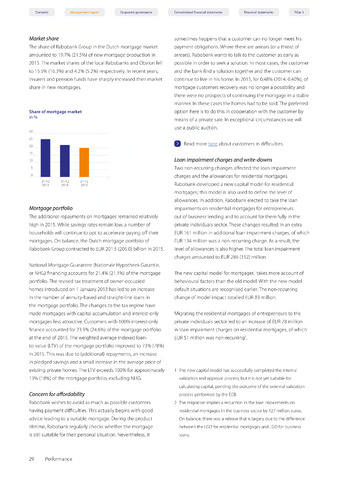Contents Management report Corporate governance Consolidated financial statements Financial statements Pillar 3
Market share
The share of Rabobank Group in the Dutch mortgage market
amounted to 19.7% (21.5%) of new mortgage production in
2015.The market shares of the local Rabobanks and Obvion fell
to 15.5% (16.3%) and 4.2% (5.2%) respectively. In recent years,
insurers and pension funds have sharply increased their market
share in new mortgages.
Share of mortgage market
in
30
III
31-12 31-12 31-12
2013 2014 2015
Mortgage portfolio
The additional repayments on mortgages remained relatively
high in 2015. While savings rates remain low, a number of
households will continue to opt to accelerate paying off their
mortgages. On balance, the Dutch mortgage portfolio of
Rabobank Group contracted to EUR 201.5 (205.0) billion in 2015.
National Mortgage Guarantee (Nationale Hypotheek Garantie,
or NHG) financing accounts for 21.4% (21.1%) of the mortgage
portfolio. The revised tax treatment of owner-occupied
homes introduced on 1 January 2013 has led to an increase
in the number of annuity-based and straight-line loans in
the mortgage portfolio.The changes to the tax regime have
made mortgages with capital accumulation and interest-only
mortgages less attractive. Customers with 100% interest-only
finance accounted for 23.9% (24.6%) of the mortgage portfolio
at the end of 2015. The weighted average indexed loan-
to-value (LTV) of the mortgage portfolio improved to 73% (78%)
in 2015.This was due to (additional) repayments, an increase
in pledged savings and a small increase in the average price of
existing private homes.The LTV exceeds 100% for approximately
13% (18%) of the mortgage portfolio, excluding NHG.
Concern for affordability
Rabobank wishes to avoid as much as possible customers
having payment difficulties. This actually begins with good
advice leading to a suitable mortgage. During the product
lifetime, Rabobank regularly checks whether the mortgage
is still suitable for their personal situation. Nevertheless, it
sometimes happens that a customer can no longer meet his
payment obligations. Where there are arrears (or a threat of
arrears), Rabobank wants to talk to the customer as early as
possible in order to seek a solution. In most cases, the customer
and the bank find a solution together and the customer can
continue to live in his home. In 2015, for 0.48% (2014: 0.40%), of
mortgage customers recovery was no longer a possibility and
there were no prospects of continuing the mortgage in a stable
manner. In these cases the homes had to be sold.The preferred
option here is to do this in cooperation with the customer by
means of a private sale. In exceptional circumstances we will
use a public auction.
O Read more here about customers in difficulties.
Loan impairment charges and write-downs
Two non-recurring changes affected the loan impairment
charges and the allowances for residential mortgages.
Rabobank developed a new capital model for residential
mortgages; this model is also used to define the level of
allowances. In addition, Rabobank elected to take the loan
impairments on residential mortgages for entrepreneurs
out of business lending and to account for them fully in the
private individuals sector. These changes resulted in an extra
EUR 161 million in additional loan impairment charges, of which
EUR 134 million was a non-recurring charge. As a result, the
level of allowances is also higher. The total loan impairment
charges amounted to EUR 286 (112) million.
The new capital model for mortgages1 takes more account of
behavioural factors than the old model. With the new model
default situations are recognised earlier.The non-recurring
change of model impact totalled EUR 83 million.
Migrating the residential mortgages of entrepreneurs to the
private individuals sector led to an increase of EUR 78 million
in loan impairment charges on residential mortgages, of which
EUR 51 million was non-recurring2.
1 The new capital model has successfully completed the interna
validation and approval process, but it is not yet suitable for
calculating capital, pending the outcome of the external validation
process performed by the ECB.
2 The migration implies a reduction in the loan impairments on
residential mortgages in the business sector by 127 million euros.
On balance, there was a release that is largely due to the difference
between the LGDfor residential mortgages and LGDfor business
loans.
29 Performance

